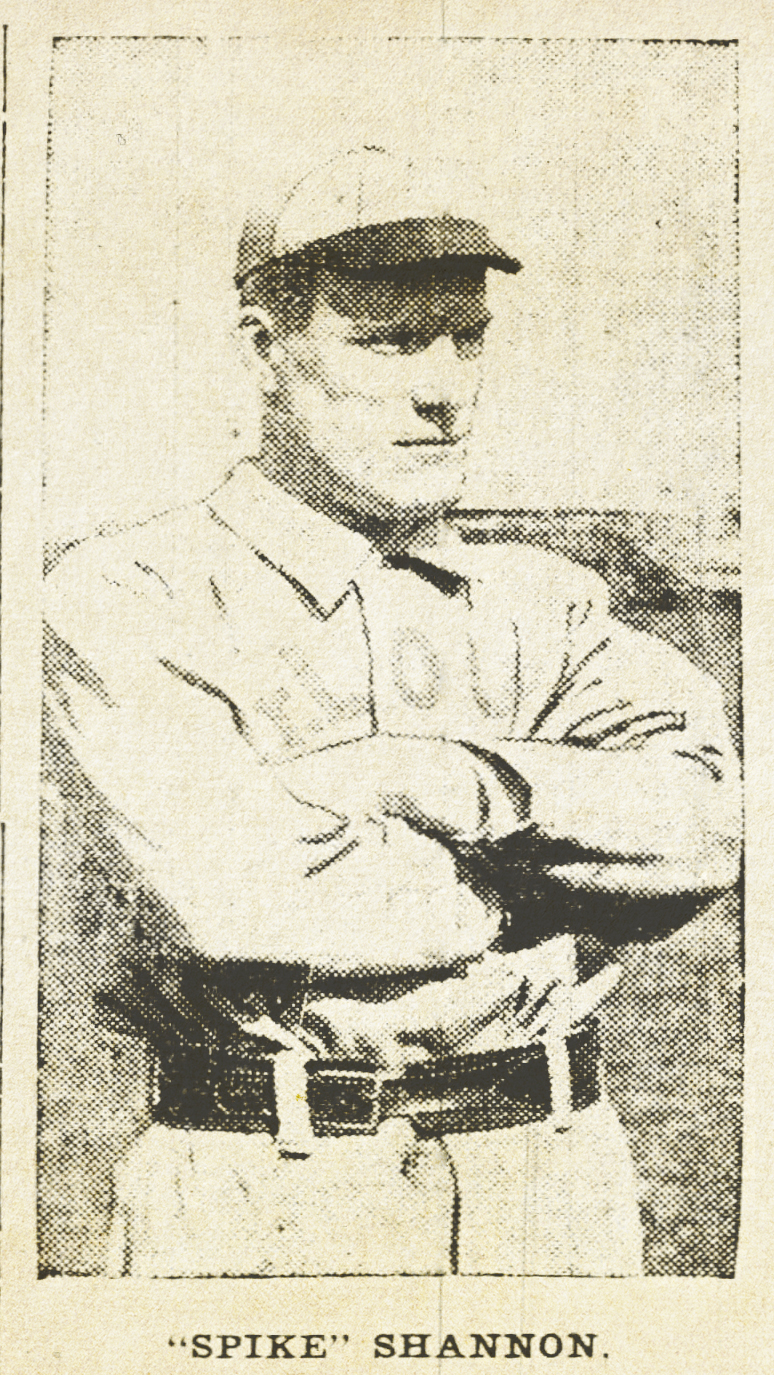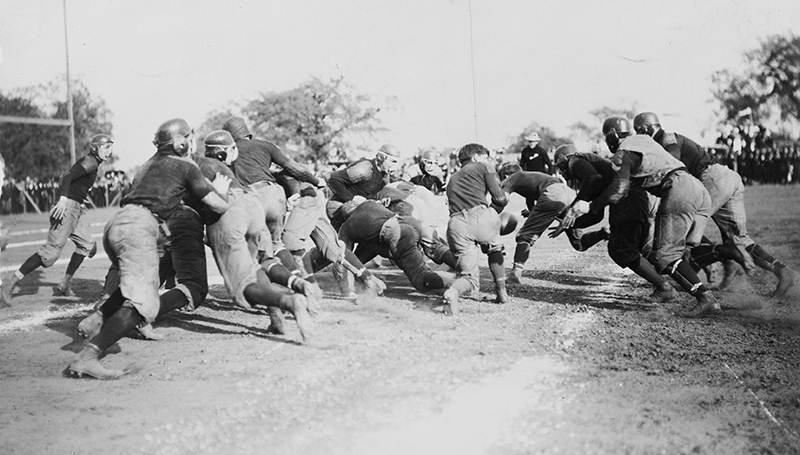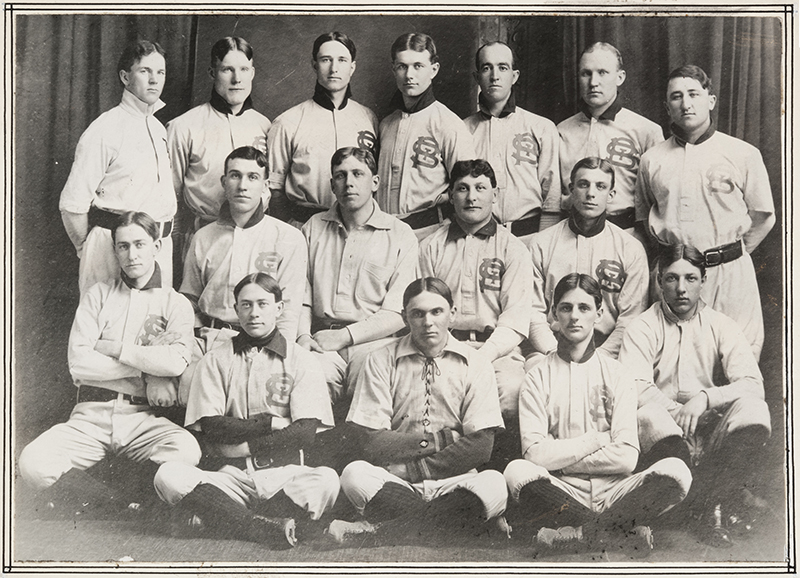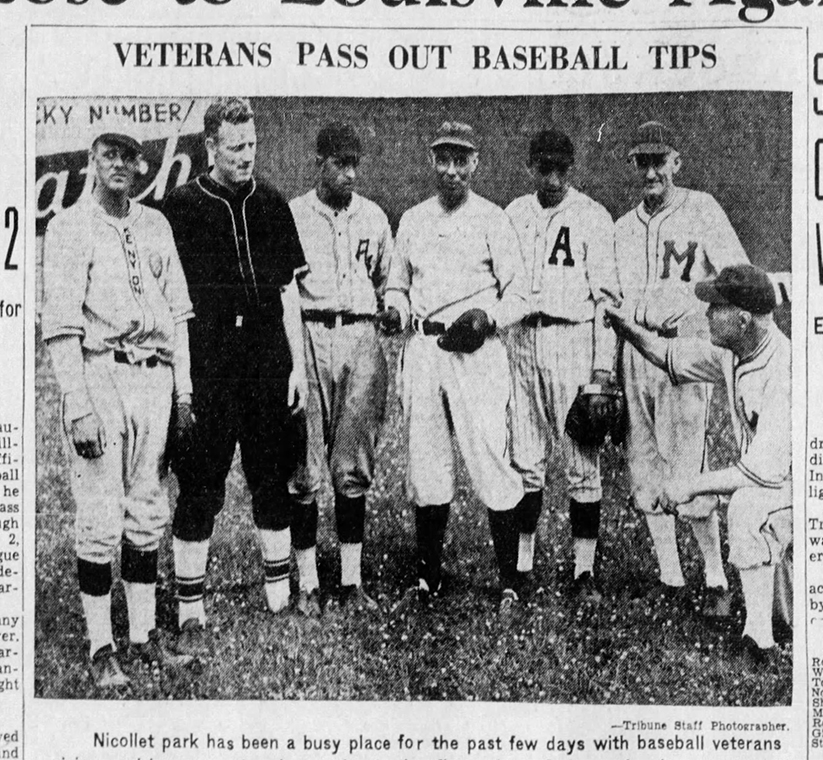"Spike" Shannon
 Spike Shannon in his St. Louis Cardinals uniform c. 1906.
Spike Shannon in his St. Louis Cardinals uniform c. 1906.
 Football game c. 1902. Courtesy of Library of Congress.
Football game c. 1902. Courtesy of Library of Congress.
William Porter "Spike" Shannon
1875-1940
William Porter Shannon, better known to baseball fans as Spike Shannon, was an outfielder who played with several minor and major league teams in the first decade of the 1900s. He was captain of the St. Louis Cardinals during their 1906 season. A native of Southwestern Pennsylvania, his final season in the majors included a brief stint with the Pittsburgh Pirates.
Early Life and Football Career
Shannon was born in Clarksburg, Indiana County, Pennsylvania, the youngest of three children of Rachel Cunningham Porter and Oliver D. Porter, a blacksmith and Civil War veteran. In August 1881, Oliver Shannon died at age thirty-nine.
Porter Shannon, as Spike Shannon was known in his youth, was a versatile athlete, competing in swimming, boxing, football and baseball. In the late 1890s and early 1900s, he lived in Oakmont and played halfback for football teams in Oakmont, Verona, Grove City and Latrobe. After standout games with Oakmont’s amateur team in the 1895 season, Shannon was recruited to play for Grove City’s college football team, where he stayed through 1898, occasionally taking turns at kicker in addition to his regular role as halfback. He played for the Verona Indians in 1899 and for Latrobe’s highly regarded football team in 1900.
In St. Paul, while he played for the minor-league Saints during baseball season, Shannon was a gridiron draw with the independent St. Paul Tigers in 1902 and 1903. He was mentioned as a possible player for a Pittsburgh football team in 1902 when there was talk of putting a club together for a new league, but the Pittsburgh Press writer, smarting from the recent demise of the Homestead All Stars, griped that “Football has always been a losing venture in this city.”
The plans to bring Spike Shannon back to Pittsburgh as a football star did not bear fruit, and Shannon remained in St. Paul. He did, however, maintain fans and friends in Southwestern Pennsylvania and made regular visits through the years. In April 1904, when his baseball career was approaching its zenith, he got a hometown reception at Exposition Park, with delegations from Oakmont, his former home, and Knoxville, where his brother, Sam, was a barber.
It was during his football career that Shannon earned the nickname which would distinguish him in the baseball world. According to a newspaper account, while playing for Grove City, Shannon suffered a broken leg during the 1897 season. He had a wooden splint tied to his ankle to help him walk while he recovered. One day, he fell and the splint broke. Shannon spiked the splint back together with hammer and nails. The nickname “Spike” stuck.
Baseball Career
Shannon played baseball concurrently with his football career in the late 1890s, alternating the sport with the seasons. He played shortstop with Oakmont’s amateur baseball team in 1895 and third base for a club in Butler in 1897.
In 1898, Shannon embarked on a career in professional baseball that would last until 1913. In the minors, he was with the Charleston Seagulls from April to May of 1898 and the Richmond Bluebirds from May to September of that same year. From 1899 to 1901, he played for Richmond, the Syracuse Stars, the Meriden Silverites, Jersey City, the Harrisburg Ponies, and the Indianapolis Hoosiers. Shannon was gaining experience as a reliable glove in the outfield.
Shannon’s star began to rise during his years with the St. Paul Saints, 1902-1903, where he played centerfield. His batting averages were .344 in 1902 and .308 in 1903 over 120 and 135 games, respectively.
What really got attention in the local sports pages was his base stealing. Known as a fast halfback in football, Shannon put his speed to work for him on the diamond. In August 1903, Shannon and his Saints teammate, future Hall of Famer Miller Huggins, led the American Association in base stealing, with 36 each, and Shannon was the runs scored leader with 136. The Saints won the pennant that year.
Shannon’s go-getting, consistent outfield work won praise with sports writers. “Shannon is also ‘some pumpkins’ in the field,” reported the St. Louis World in 1905. The St. Paul Globe described a breathtaking somersault catch by Shannon that snuffed out a rally in the ninth inning by the Columbus Senators in July 1903: “He came charging in on Wagner’s low, short fly, grabbed the ball off his toe, fell down, rolled over and got up again in time to keep Clingman from scoring from third.”
A New York sportswriter described Spike Shannon as “perhaps the most wonderful run-getter in either league. Spike isn’t a ten-second man when it comes to sprinting, but he can cut pretty close to that mark and, better than that, he uses his head when on the bases as few base-runners use their heads. There is no trick of the game that Spike hasn’t thoroughly mastered, and when he ‘gets on,’ which is very often, he is very likely to get around.”
Shannon was on the Cincinnati Reds’ draft list in 1903, having been recommended by Miller Huggins. But his entry into the majors would have to wait one more season because the Reds’ president August Herrmann determined there wasn’t a slot on the roster for the outfielder.
Spike Shannon was just starting to put down roots in St. Paul – he got married to Minneapolis native Sarah “Sadie” Murphy in 1903 and bought a saloon in 1904 – when, as luck would have it, the St. Louis Cardinals called him up.
Shannon was the Cardinals’ right fielder in the 1904 season under manager Patsy Donovan, then took over the left field position in 1905 and 1906. In 1906, he was named the Cardinals’ team captain by manager John McCloskey, who liked Shannon’s aggressive game and said the team needed more of the red-headed left fielder’s “ginger.” The Minneapolis Journal agreed with the choice, noting that Shannon’s “fielding has been brilliant” with the Cardinals and that “he is fast and daring on the bases.”
Shannon played only half the 1906 season with the Cardinals, however, because in early July of that year, he was bought by the New York Giants in a $10,000 deal, a huge sum in baseball at the time. Shannon’s contract with the Giants was for two years, and he would continue playing left field.
Despite being the National League’s leader in runs scored (104) in 1907, Shannon’s overall performance with the Giants did not live up to the expectations of manager John McGraw, and in July 1908 Shannon was traded to the Pittsburgh Pirates. He spent only a few months with the Bucs without playing many games. The Pirates were his last team in the majors.
Shannon played three seasons with the Kansas City Blues (1909-1911) under manager Danny Shay, his former Cardinals teammate. At 36, however, he was aging out of the game, his legs no longer carrying him swiftly around the diamond. He spent 1912 as a catcher with teams in Butte and Great Falls, Montana. Shannon closed out his baseball career as a player with the Virginia Ore Diggers (1913), based in Virginia, Minnesota. He was also the Ore Diggers’ manager for part of the 1913 season.
Over the next two decades, Shannon umpired in minor-league baseball, working for the Northern, Federal, Western and Southern Leagues and the American Association, in games from Minnesota to Oklahoma to California. His wife, Sadie, sometimes accompanied him on these travels, although they maintained their permanent home in Minneapolis.
During the off seasons, Shannon worked various blue-collar jobs as a carpenter, sign painter and miner. The 1920 Census registers him as living and working in a mining camp in Picher, Oklahoma, part of a tri-state area (along with southwestern Missouri and southeast Kansas) which at the time provided 43% of the nation’s lead and zinc ore.
 1903 St. Paul Saints baseball team. Spike Shannon is in the top row, second from left. Courtesy of Minnesota Historical Society.
1903 St. Paul Saints baseball team. Spike Shannon is in the top row, second from left. Courtesy of Minnesota Historical Society.
 In 1906, Spike Shannon became the youngest team captain in the major leagues when he was named captain of the St. Louis Cardinals.
In 1906, Spike Shannon became the youngest team captain in the major leagues when he was named captain of the St. Louis Cardinals.
 Spike Shannon's performance in the outfield won praise from managers and sports writers.
Spike Shannon's performance in the outfield won praise from managers and sports writers.
 Spike Shannon and other baseball veterans offered a baseball clinic to Minneapolis youths in 1935. Shannon is on the right, kneeling.
Spike Shannon and other baseball veterans offered a baseball clinic to Minneapolis youths in 1935. Shannon is on the right, kneeling.
After Baseball
Shannon appears to have worked his last season as an umpire in 1931. He took up a new game, golf, and became good enough at it that he got a job at a Minneapolis golf practice facility. He never lost touch with his baseball friends and joined the old timers’ annual reunions.
In 1935, he and his baseball veteran friends sponsored a youth baseball clinic in Nicollet Park baseball field, which was literally around the corner from Shannon’s house on East Lake Street.
Spike Shannon opened his Dollar Bank savings account under his birth name, William Porter Shannon, in October 1901.
